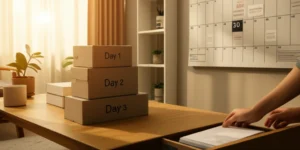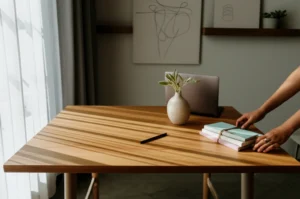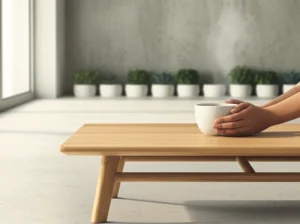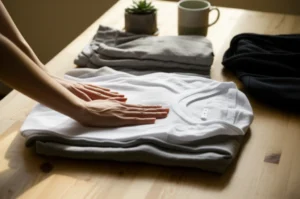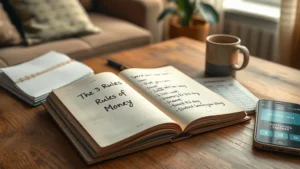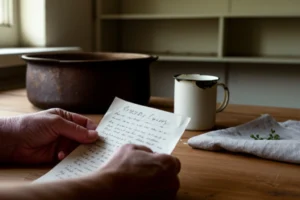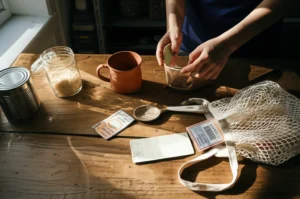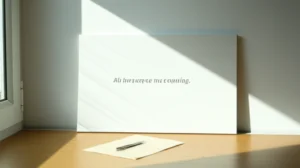What if you could open your closet, peek under your bed, paw through your junk drawer, and not feel a wave of stress—or the shamey heat that comes from realizing how much money is hiding in all that mess?
Imagine this: every single thing you own is something you use, love, or need. Nothing more, nothing less. Your home actually feels bigger, your head feels clearer, and you stop wasting time searching for your favorite socks because, surprise—they’re always in the same place. That’s what a minimalist possessions list can do for you. If you’re looking for a straight-up answers, a pinch of real-life sweat, and zero fluff, grab your metaphorical backpack and let’s dive deep into living well with less.
What Actually Is a Minimalist Possessions List?
If you typed “minimalist possessions list” into the search bar hoping to find a “just copy this” answer or some magical number of items to live by—hey, you’re not alone. Maybe you stumbled on an article about someone living with 100 items, or the woman who laid out everything she owned on her living room floor and counted each sock. It sounds kind of extreme, but at its core, the heart of minimalism isn’t deprivation. It’s about being conscious, intentional, and a little bit daring with what you allow into your space and your life.
People are usually hungry for:
- Ready-made lists to copy (like a 100 items minimalist list—don’t worry, we’ll talk about it)
- Real, actionable steps to start their own list
- Stories and real-life proof that less stuff really does mean more freedom
So, let’s get ultra-honest—having “less” isn’t about making your life boring or sterile. It’s about kicking out the things that weigh you down, so you can focus on what actually lifts you up.
Easy Rules for Counting (Or, How Not to Lose Your Mind)
First things first: there isn’t a universal judge who comes to your house and checks if you’re allowed to keep those extra black jeans. Minimalism is deeply personal. That said, a minimalist possessions list works best if you set some simple, flexible rules:
What (and How) to Count
- Count pairs as one (A pair of socks? One item. Earrings, too.)[4]
- Total up individual items for clarity (Toothbrush, check. Phone charger, check.)
- Group or exclude consumables (Food, bathroom supplies, empty notebooks—up to you)
- Ignore your roommate’s/partner’s/kid’s stuff, unless you’re purging together (Trust me, don’t lose friends over laundry baskets.)
- Be gentle with yourself about essentials. Don’t toss your only winter coat because “lists said so.”
How Do You Decide What Stays?
- Ask: Do I use this daily, weekly, monthly—or not at all?
- Does this item solve more than one problem? (Looking at you, multitasking kitchen shears.)
- Is it in good repair or weirdly sticky? (If you said sticky, maybe let it go.)
- Is sentimental value enough to justify the space? Give yourself a “sentimental box” or a dedicated shelf and honor the limit.
- Do I already own something that could replace this?
Make it a journey, not a competition. Nobody’s handing out medals for the lowest item count—though, if there were, I’d love to see the ceremony.
The Weird Truth: Less Stuff, More Freedom (And the Risks!)
I won’t lie. Minimalism is freeing, uplifting, sometimes addictive—but it isn’t always easy. Here’s the upside:
- You spend less time cleaning, repairing, and hunting for things[2].
- Your space feels open and, frankly, more like a chill Airbnb than your usual messy crash pad.
- Your wallet thanks you (less impulse buying, fewer “fill-the-space” spends).
- Your mind gets a little peace—for real. Clinical studies have linked clutter-free spaces to lower stress (according to studies on clutter and mental wellbeing).
But, a word of warning: Take it too far, and you might feel deprived or cut off from things you actually enjoy. That’s not winning. Make your list your own, even if you need that second frying pan—or ten pairs of running shoes because, hey, running is life. There’s no minimalist police.
A Peek at Real Minimalist Possessions Lists (So You Know This Isn’t Just Theory)
The Ultra-Light Nomad: Around 50–75 Items
This is for the brave-of-heart and always-on-the-move. Think world travelers, digital nomads, or folks ready to fit their lives into one suitcase. You’ll see the tiniest of lists out there—like Colin Wright’s 51 things or Leo Babauta’s 50—where every piece fights fiercely for a spot. The focus? Clothing layers, a trusty all-weather jacket, a tiny tech kit, and rarely more than one of anything.
The 100-Item Classic—Minimalism’s Secret Sauce
If you’re itching to downsize but not sure how drastic you want to go, try modeling after the 100 items minimalist list. The trick is to count carefully (pairs as one), and admit where you need wiggle room—like toiletries, basic tech, and key sentimental items[4]. Here’s a rough breakdown from someone who lived it:
- About 25 pieces of clothing (shoes, socks, underwear, outerwear included)
- Small tech setup: laptop/phone/charger/headphones
- A compact kitchen (one pot, one pan, set of silverware)
- Bedding and maybe that one pillow you can’t sleep without
- Sentimental box (yeah, it gets its own line)
Comfort-First Minimalism: 130–200 Items and Up
Not ready to live out of a backpack? Good news—you’re in the biggest club. Most real-life minimalists (especially families) land somewhere between 130 and 300 things. For example, one couple who hit the road traveling kept just 134 possessions, missing maybe one kitchen tool and occasionally, the perfect pillow. They swear they didn’t regret it, but also didn’t obsess over every count[2].
The “I Counted It All and I’m Still Happy” List (a.k.a. The 288 Items List)
The Minimalists tallied everything, including the clock on the wall—and hit 288. They cheat a little (grouping hangers, counting every pair as a single item), but the point shines through: intentionality beats numbers. Their list includes:
| Category | Example Items | Count |
|---|---|---|
| Casual Clothes | Jeans, hoodies, t-shirts | 79 |
| Dress Clothes | Suits, ties, dress shirts | 50 |
| Life Tools | Car, guitar, books, hairbrush | 33 |
| Kitchen | Pots, pans, utensils, coffeemaker | 19 |
| Furniture | Bed, couch, coffee table | 18 |
Surprised at what counts? Every home, routine, and amount of “stuff” is personal. Your own minimalist possessions list might be half this—or double.
Room-by-Room: Minimalist Essentials List (A Quickfire Guide)
Wardrobe: Dress Simply, Dress Smart
You don’t need a closet that rivals a department store. If minimalist lifestyle clothing speaks to you, focus on a capsule wardrobe: 7–10 tops, 3–5 bottoms, a handful of quality layers, and two or three pairs of shoes. Toss (or donate) anything that doesn’t make you feel comfortable, isn’t in rotation this season, or is pure fashion guilt. Remember, you can always rotate a few seasonal pieces in a storage bin—just keep it small.
Bathroom & Personal Care: Keep It Clean and Lean
Bring it down to the essentials: toothbrush, toothpaste, shampoo (or that magical all-in-one bar), razor, a bit of first-aid, and any daily must-haves. If makeup is your jam, pick your favorites and keep them bagged, not sprawling all over the counter. One towel per person, maybe a spare for guests—it’s all you really need.
Kitchen & Dining: The Multi-Tasker’s Playground
Minimalist items for home kitchens are about multi-use: one skillet, one saucepan, a spatula, a sharp knife, and dishes for the people in your household—plus one or two for spontaneous dinner guests. Purge duplicates, gadgets you never use, and stained containers. Can’t bear to part with the waffle iron? Store it out of sight for a month; if you don’t reach for it, it’s probably not essential.
Living Space: Make Room for Living
Keep only the furniture you need to be comfortable—like a couch, table, and a chair or two. Decorations? Yes, minimalism doesn’t mean a home that looks like it was abandoned mid-move. Keep only what you truly love to see, not just what fills space. Books can be tricky: if you love them, a curated shelf is worth keeping; otherwise, libraries and digital readers are your best friend.
How to Start Your Own Minimalist Possessions List (No Perfection Required)
Okay, let’s skip the horror stories of 12-hour purges. Here’s a practical, humane way to start:
- Pick your smallest, least emotional room. Maybe your bathroom or a hallway closet. Lay everything out.
- Sort things into daily use, weekly/monthly use, or “what the heck is this?”
- Ask the hard questions (see above), then make a “keep”, “donate/sell”, or “maybe” pile. No guilt about the “maybes”—they go into a box labeled with a 30-day timer.
- Count your keepers. Don’t obsess. Just jot the number so you notice progress—if you’re tracking toward a 100 items minimalist list or want to set your own benchmark.
- Finish one room. Breathe. Repeat later for the next space.
If digital clutter is a problem, hey, it counts too—clear out old files, unused apps, and ancient cords from your tech drawer. Less is soothing no matter where it lives.
What Can You Expect to Happen?
Honestly? The first feeling is weird. You might panic (“I need that just in case!”), then feel relief, then a bizarre joy. Maybe your house echoes for a day, but soon it feels lighter—like losing a big, invisible backpack you didn’t know you’d been carrying.
Real talk: Sometimes you’ll regret tossing something and have to buy it again. It happens. But way more often, you won’t remember what’s missing except every morning when you realize you aren’t fighting clutter, you’re just living.
Responsible Letting Go: Do It Kind, Do It Right
As you cut down, don’t just shovel things into a landfill bag. Donate gently used items to local shelters or organizations. Sell what might bring someone else joy. Recycle electronics—look up programs in your city if you’re not sure how. If you’re feeling clever, you can even try the growing sharing economy and borrow or rent those “maybe once-a-year” items. (A trimmer, a waffle maker, ski equipment—sometimes it’s smart not to own it at all.)
Why You’ll Keep Coming Back to This Crazy Practice
I started with a single box in the middle of my living room—tossed in all the stuff I hadn’t touched for a year. It wasn’t glamorous or pretty, but it felt good. One tote became a trunk, then a carload to Goodwill, and suddenly, not only did I remember what I owned, but I started to enjoy it. My favorite stories? People who start with a minimalist list and, even if they drift back to “more,” never regret clearing the space for better things—be it time, cash, or a mind that’s finally calm.
Conclusion: Minimalism Isn’t About Numbers—It’s About Freedom and Joy
Your minimalist possessions list isn’t about a magic number—though benchmarks like 50, 100, or even 288 items are inspiring in their quirky way. It’s a tool for looking at your stuff (and your life) with clear eyes and open hands. What you keep should serve you, not the other way around. There’s no trophy for owning less, but there’s deep satisfaction in living with intention.
Here’s your nudge: Start small. Set aside one hour this week and try a room-by-room mini-purge. If you’re curious about what it feels like (or if you’re ready for a wild challenge), look up a 100 items minimalist list and see if any inspiration sparkles. Whether you hit 50 items or 500, the point is peace—more space for you, your people, and the life you actually want to live. Let me know what you’re holding onto (and why), or what you dream of letting go. This messy, beautiful journey is always better together.


